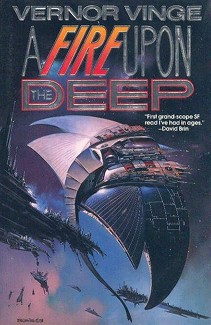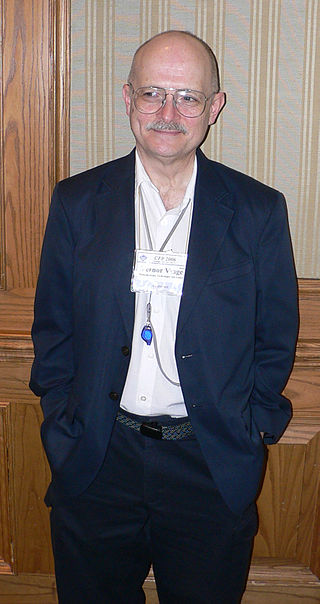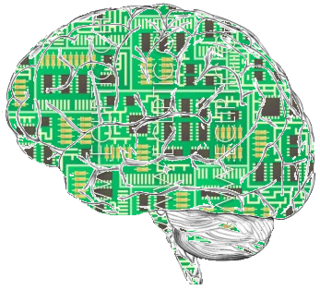Related Research Articles

A Fire Upon the Deep is a 1992 science fiction novel by American writer Vernor Vinge. It is a space opera involving superhuman intelligences, aliens, variable physics, space battles, love, betrayal, genocide, and a communication medium resembling Usenet. A Fire Upon the Deep won the Hugo Award in 1993, sharing it with Doomsday Book by Connie Willis.
An ansible is a category of fictional devices or technology capable of near-instantaneous or faster-than-light communication. It can send and receive messages to and from a corresponding device over any distance or obstacle whatsoever with no delay, even between star systems. As a name for such a device, the word "ansible" first appeared in a 1966 novel by Ursula K. Le Guin. Since that time, the term has been broadly used in the works of numerous science fiction authors, across a variety of settings and continuities. A related term is ultrawave.

Vernor Steffen Vinge is an American science fiction author and retired professor. He taught mathematics and computer science at San Diego State University. He is the first wide-scale popularizer of the technological singularity concept and among the first authors to present a fictional "cyberspace". He has won the Hugo Award for his novels A Fire Upon the Deep (1992), A Deepness in the Sky (1999), Rainbows End (2006), and novellas Fast Times at Fairmont High (2002), and The Cookie Monster (2004).
The technological singularity—or simply the singularity—is a hypothetical future point in time at which technological growth becomes uncontrollable and irreversible, resulting in unforeseeable consequences for human civilization. According to the most popular version of the singularity hypothesis, I. J. Good's intelligence explosion model, an upgradable intelligent agent will eventually enter a "runaway reaction" of self-improvement cycles, each new and more intelligent generation appearing more and more rapidly, causing an "explosion" in intelligence and resulting in a powerful superintelligence that qualitatively far surpasses all human intelligence.

Sentience is the simplest or most primitive form of cognition, consisting of a conscious awareness of stimuli without association or interpretation. The word was first coined by philosophers in the 1630s for the concept of an ability to feel, derived from Latin sentiens (feeling), to distinguish it from the ability to think (reason).

An overwhelming majority of fiction is set on or features the Earth, as the only planet home to humans. This also holds true of science fiction, despite perceptions to the contrary. Works that focus specifically on Earth may do so holistically, treating the planet as one semi-biological entity. Counterfactual depictions of the shape of the Earth, be it flat or hollow, are occasionally featured. A personified, living Earth appears in a handful of works. In works set in the far future, Earth can be a center of space-faring human civilization, or just one of many inhabited planets of a galactic empire, and sometimes destroyed by ecological disaster or nuclear war or otherwise forgotten or lost.
A hive mind or group mind may refer to:
Orion's Arm is a multi-authored online science fiction world-building project, first established in 2000 by M. Alan Kazlev, Donna Malcolm Hirsekorn, Bernd Helfert and Anders Sandberg and further co-authored by many people since. Anyone can contribute articles, stories, artwork, or music to the website. A large mailing list exists, in which members debate aspects of the world they are creating, discussing additions, modifications, issues arising, and work to be done.
In American science fiction of the 1950s and 1960s, psionics was a proposed discipline that applied principles of engineering to the study of paranormal or psychic phenomena, such as extrasensory perception, telepathy and psychokinesis. The term is a blend word of psi and the -onics from electronics. The word "psionics" began as, and always remained, a term of art within the science fiction community and—despite the promotional efforts of editor John W. Campbell, Jr.—it never achieved general currency, even among academic parapsychologists. In the years after the term was coined in 1951, it became increasingly evident that no scientific evidence supports the existence of "psionic" abilities.
Singularitarianism is a movement defined by the belief that a technological singularity—the creation of superintelligence—will likely happen in the medium future, and that deliberate action ought to be taken to ensure that the singularity benefits humans.
Literary fiction, mainstream fiction, non-genre fiction, serious fiction, high literature, artistic literature, and sometimes just literature, are labels that, in the book trade, refer to market novels that do not fit neatly into an established genre ; or, otherwise, refer to novels that are character-driven rather than plot-driven, examine the human condition, use language in an experimental or poetic fashion, or are simply considered serious art.
The philosophy of artificial intelligence is a branch of the philosophy of mind and the philosophy of computer science that explores artificial intelligence and its implications for knowledge and understanding of intelligence, ethics, consciousness, epistemology, and free will. Furthermore, the technology is concerned with the creation of artificial animals or artificial people so the discipline is of considerable interest to philosophers. These factors contributed to the emergence of the philosophy of artificial intelligence.

Intelligence amplification (IA) refers to the effective use of information technology in augmenting human intelligence. The idea was first proposed in the 1950s and 1960s by cybernetics and early computer pioneers.

The concept of uploading a mind into a computer, often into a simulated reality, is a recurring theme in science-fiction novels and films since the 1950s. Some stories describe societies of such minds.
In science fiction, a time viewer, temporal viewer, or chronoscope is a device that allows another point in time to be observed. The concept has appeared since the late 19th century, constituting a significant yet relatively obscure subgenre of time travel fiction and appearing in various media including literature, cinema, and television. Stories usually explain the technology by referencing cutting-edge science, though sometimes invoking the supernatural instead. Most commonly only the past can be observed, though occasionally time viewers capable of showing the future appear; these devices are sometimes limited in terms of what information about the future can be obtained. Other variations on the concept include being able to listen to the past but not view it.

Brave New Words: The Oxford Dictionary of Science Fiction is a book published in 2007 by the Oxford University Press. It was edited by Jeff Prucher, with an introduction by Gene Wolfe.
"Bookworm, Run!" is a science fiction short story by American writer Vernor Vinge. His second published work of fiction, it appeared in Analog Science Fiction Science Fact in 1966, and was reprinted in True Names... and Other Dangers in 1987, and in 2001's The Collected Stories of Vernor Vinge.

Immortality is a common theme in fiction. The concept has been depicted since the Epic of Gilgamesh, the oldest known work of fiction. Originally appearing in the domain of mythology, it has later become a recurring element in the genres of horror, science fiction, and fantasy. For most of literary history, the dominant perspective has been that the desire for immortality is misguided, albeit strong; among the posited drawbacks are ennui, loneliness, and social stagnation. This view was challenged in the 20th century by writers such as George Bernard Shaw and Roger Zelazny. Immortality is commonly obtained either from supernatural entities or objects such as the Fountain of Youth or through biological or technological means such as brain transplants.

Soft science fiction, or soft SF, is a category of science fiction with two different definitions, defined in contrast to hard science fiction. It can refer to science fiction that explores the "soft" sciences, as opposed to hard science fiction, which explores the "hard" sciences. It can also refer to science fiction which prioritizes human emotions over the scientific accuracy or plausibility of hard science fiction.
References
- ↑ "Coalescing minds: brain uploading-related group mind scenarios" by Kaj Sotala, Department of Computer Science, University of Helsinki. January 2012.
- 1 2 Prucher, Jeff (2009). "Group Mind n.". Brave New Words: The Oxford Dictionary of Science Fiction . Oxford: Oxford University Press. p. 86. ISBN 978-0-19-538706-3. OCLC 319869032.
- 1 2 Stableford, Brian M; Langford, David (June 13, 2017). "Hive Minds". In Clute, John; Langford, David; Nicholls, Peter; Sleight, Graham (eds.). The Encyclopedia of Science Fiction (3rd ed.). London: Gollancz.
- ↑ "Group Ego by Robert Heinlein from Methuselah's Children". www.technovelgy.com. Retrieved 2020-12-20.
- ↑ "group mind n." Science Fiction Citations for the OED. Archived from the original on 2013-01-26. Retrieved 2020-12-21.
- ↑ Zimmer, Ben (2015-12-29). "'Hive Mind,' From Beekeeping to Economics". Wall Street Journal. ISSN 0099-9660 . Retrieved 2020-12-20.
- 1 2 Prucher, Jeff (2009). "Hive Mind n.". Brave New Words: The Oxford Dictionary of Science Fiction . Oxford: Oxford University Press. pp. 88–89. ISBN 978-0-19-538706-3. OCLC 319869032.
- ↑ "What is another word for "group mind"?". Word Hippo. Retrieved 2020-12-22.
- ↑ Sokol, Joshua (2019-05-14). "Striking Down the Queen Won't Save You From the Swarm (Published 2019)". The New York Times. ISSN 0362-4331 . Retrieved 2020-12-03.
- ↑ Vernor Vinge, The Children of the Sky, Tor, 2011, p. 167
- ↑ Stableford, Brian M. (Jan 1, 1987). The Sociology of Science Fiction (PDF) (PhD). University of York.